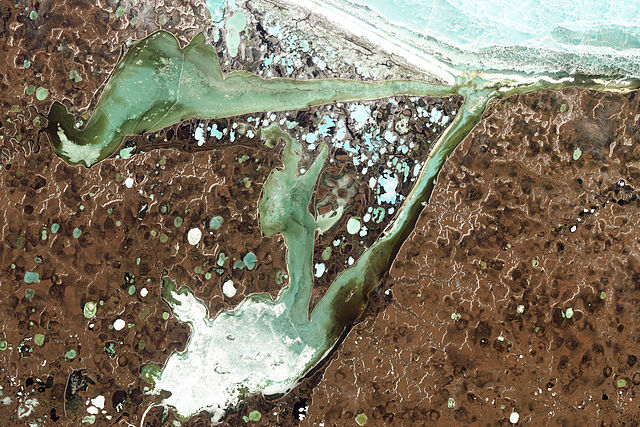7 December 2012
Heat Release From Eurasian Soils Amplifies Arctic Warming
Posted by kramsayer

Increased annual heat flux from Eurasian soils thaws permafrost and changes regional climate patterns. The Siberian landscape shone above is dotted with thermokarst lakes, those formed as permafrost melts. (Credit: NASA/ Jesse Allen and Robert Simmon).
Two of the strongest knobs on Earth’s thermostat sit in the Arctic: sea ice and permafrost. Both spur feedback loops that can ripple down to lower latitudes and alter global weather patterns. Melting sea ice reveals dark open ocean that absorbs heat and further melts ice. Melting permafrost thaws organic matter that releases greenhouse gases and causes further thawing.
Oliver Frauenfeld, a climatologist at Texas A&M University, thinks he has found another important knob on Earth’s thermostat that has hitherto been overlooked. During a poster session Wednesday morning at the 2012 AGU Fall Meeting in San Francisco, he showed that thawing Arctic soils in Eurasia are releasing increasing volumes of heat to the atmosphere that could change regional atmospheric patterns and jostle global climate.
He attributes the increase in soil heat release to rising summertime temperatures. As soils absorb more summertime heat, they accrue that much more heat, which is later released at the onset of winter. Since this is when permafrost begins to grow, this heat release dampens permafrost formation.
Frauenfeld’s results are based on monthly heat flux data collected from 423 Russian-monitored field sites over the period of 1956-2000.
While the trends are compelling, the data still lack important information.
Frauenfeld and his graduate student, Liang Chen, are working to compliment the heat flux data with information about soil characteristics that could help better explain their observed trends. Because moist soil holds more heat than dry soil, identifying changes in soil moisture will help them determine how much heat is released from soil moisture changes versus changes in summertime temperatures.
Frauenfeld thinks that their results have important implications for global climate change, but concedes that sea ice loss remains the dominant driver of Earth’s thermometer.
“Once the ice is gone, it’s gone,” he said. “But on land, the processes are much more gradual so we would not see anything that dramatic.”
Still, he notes, the gradual increase in heat release from the soil will continue to thwart permafrost formation, increase greenhouse gas emissions from decomposing soils, and contribute to runaway Arctic change.
– Laura Poppick is a graduate student in the UC Santa Cruz Science Communication Program


 GeoSpace is a blog on Earth and space science, managed by AGU’s Public Information staff. The blog features posts by AGU writers and guest contributors on all sorts of relevant science topics, but with a focus on new research and geo and space sciences-related stories that are currently in the news.
GeoSpace is a blog on Earth and space science, managed by AGU’s Public Information staff. The blog features posts by AGU writers and guest contributors on all sorts of relevant science topics, but with a focus on new research and geo and space sciences-related stories that are currently in the news.